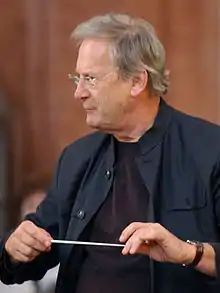Barmherziges Herze der ewigen Liebe, BWV 185
Johann Sebastian Bach composed the church cantata Barmherziges Herze der ewigen Liebe (Merciful heart of eternal love),[1] BWV 185 in Weimar for the fourth Sunday after Trinity and first performed it on 14 July 1715.
| Barmherziges Herze der ewigen Liebe | |
|---|---|
BWV 185 | |
| Church cantata by J. S. Bach | |
 The Schlosskirche in Weimar | |
| Occasion | Fourth Sunday after Trinity |
| Cantata text | |
| Chorale | |
| Performed | 14 July 1715: Weimar |
| Movements | 6 |
| Vocal | SATB soloists and choir |
| Instrumental |
|
Bach composed the cantata as concertmaster in Weimar, responsible for one church cantata per month. The text was written by the court poet Salomon Franck for the occasion and published in 1715. He included as the closing choral the first stanza of Johannes Agricola's hymn "Ich ruf zu dir, Herr Jesus Christ". The cantata is structured in six movements begins with a duet, followed by a sequence of alternating arias and recitatives and closed by a four-part chorale. It is scored for a small ensemble of four vocal parts, oboe, strings and continuo.
Bach led the first performance in the court chapel of Schloss Weimar on 14 July 1715. He performed the cantata again, with small instrumental revisions, at the beginning of his tenure as Thomaskantor in Leipzig, coupled with the new cantata Ein ungefärbt Gemüte, BWV 24.
History and words
On 2 March 1714 Bach was appointed concertmaster of the Weimar court capelle of the co-reigning dukes Wilhelm Ernst and Ernst August of Saxe-Weimar. As concertmaster, he assumed the principal responsibility for composing new works, specifically cantatas for the Schlosskirche[2] (palace church), on a monthly schedule.[3] He wrote this cantata for the Fourth Sunday after Trinity.[2]
The prescribed readings for the Sunday were from the Epistle to the Romans, "For the earnest expectation of the creature waiteth for the manifestation of the sons of God" (Romans 8:18–23), and from the Sermon on the Mount in the Gospel of Luke: the injunctions to "be merciful", "judge not" (Luke 6:36–42). The cantata text was written by the court poet Salomon Franck for the occasion and published in 1715 in Evangelisches Andachts-Opffer.[2] Franck stayed close to the theme of the gospel, recalling the injunctions and the parables of the mote and the beam and the blind leading the blind.[2] The last aria summarizes the admonitions as "Das ist der Christen Kunst" (This is the Christians' art).[1] The cantata is closed by the first stanza of Johannes Agricola's hymn "Ich ruf zu dir, Herr Jesus Christ" (1531).[2] Albert Schweitzer criticized the libretto as "bland, lesson-like".[4]
Bach first performed the cantata on 14 July 1715. He dated it himself "1715".[2] When Bach performed the cantata again in Leipzig on 20 June 1723, he transposed it from F-sharp minor to G minor and made changes to the instrumentation.[5] In that service, his fourth in Leipzig, he performed it together with a new cantata Ein ungefärbt Gemüte, BWV 24, after he had started his tenure as cantor with cantatas in two parts, Die Elenden sollen essen, BWV 75, and Die Himmel erzählen die Ehre Gottes, BWV 76.[6] He treated the same chorale in the chorale cantata Ich ruf zu dir, Herr Jesu Christ, BWV 177, for the same occasion in 1724. Bach revived the cantata once more in 1746 or 1747.[5]
Music
Structure and scoring
Bach structured the cantata in six movements, beginning with a duet, followed by a series of alternating recitatives and arias and concluded by a chorale.[7] Similar to several other cantatas on words by Franck, it is scored for a small ensemble: four vocal soloists (soprano (S), alto (A), tenor (T) and bass (B)), oboe (Ob), two violins (Vl), viola (Va), and basso continuo (Bc) including bassoon (Fg).[8] A choir is only needed for the chorale, if at all. The score, partly an autograph, is titled "Concerto. / Dominica post Trinit: / Brmhertziges Hertze der ewigen Liebe. ect. / â 5 Strom. 4 Voci / Tromba / 1 Hautb 2 Violini. 1 Viola. / Violoncello / è Fagotto. S. A. T. è Baßo con Cont. / di JSbach. / 1715", while "tromba" (trumpet) is struck in the cover of the set of parts.[9]
In Leipzig the oboe was replaced by a clarino (trumpet) for the instrumental cantus firmus of the chorale in the first movement. The duration is given as 16 minutes.[2]
In the following table of the movements, the scoring and keys are given for the version performed in Weimar in 1714. The keys and time signatures are taken from the Bach scholar Alfred Dürr, using the symbol for common time (4/4).[2][8] The instruments are shown separately for winds and strings, while the continuo, playing throughout, is not shown.
| No. | Title | Text | Type | Vocal | Winds | Strings | Key | Time |
|---|---|---|---|---|---|---|---|---|
| 1 | Barmherziges Herze der ewigen Liebe | Franck | Duet | S T | Ob | F-sharp minor | 6/4 | |
| 2 | Ihr Herzen, die ihr euch in Stein und Fels verkehret | Franck | Recitative | A | Fg | 2Vl Va | ||
| 3 | Sei bemüht in dieser Zeit | Franck | Aria | A | Ob Fg | 2Vl Va | A major | |
| 4 | Die Eigenliebe schmeichelt sich | Franck | Recitative | B | Fg | |||
| 5 | Das ist der Christen Kunst | Franck | Aria | B | Fg | (2Vl Va) | B-flat minor | |
| 6 | Ich ruf zu dir, Herr Jesus Christ | Agricola | Chorale | SATB | Ob Fg | 2Vl Va | F-sharp minor |
1

The opening movement is a duet of soprano and tenor, "Barmherziges Herze der ewigen Liebe" (Compassionate heart of eternal love).[2] It is in two ways connected to the chorale which closes the work.[2] The melody is played line by line as a cantus firmus by the oboe, embellished and in a dancing 6/4 time instead of 4/4.[6] The first interval in the voices and the continuo is the same as in the chorale. The countersubject is the inversion of the theme, in German "Spiegelung" (reflection in a mirror). It reflects the theme as human mercy should reflect divine mercy.[2] John Eliot Gardiner, who conducted the Bach Cantata Pilgrimage with the Monteverdi Choir in 2000, comments in his diary of the project: "Cast as a siciliano for soprano and tenor with cello continuo, there is a warm glow to this opening duet, with trills on each of the main beats to signify the flickering flame of love, and a plea to 'come melt my heart'. Agricola's chorale tune [...] is meanwhile intoned by a clarino hovering above the two amorous vocal lines.[4]
2
The alto recitative, "Ihr Herzen, die ihr euch in Stein und Fels verkehret" (You hearts, which have changed yourselves into rocks and stones),[1] is first accompanied by the strings, but ends as an arioso with continuo.[6]
3
The alto aria, "Sei bemüht in dieser Zeit" (Be inspired at the present time)[1] shows the richest instrumentation, with figurative oboe solos.[6]
4
The bass recitative "Die Eigenliebe schmeichelt sich!" (Self-love flatters itself!)[1] is accompanied only by the continuo.[2]
5
The text of the bass aria with continuo, "Das ist der Christen Kunst" (This is the Christian's art),[1] summarizes all injunctions in one long sentence, but Bach splits it in parts, all introduced by the keywords "Das ist der Christen Kunst". The bass as the vox Christi (voice of Christ) delivers the "sermon".[2] In Leipzig, the continuo of cello and bass in octaves was doubled by the strings, another octave higher.[6] Gardiner admires Bach's treatment as a "gentle, parodistic way he portrays the rhetorical displays of a pompous preacher".[4]
6
The closing chorale, "Ich ruf zu dir, Herr Jesu Christ" (I call to You, Lord Jesus Christ),[1] summarizes the topic of the cantata to love and serve the neighbour.
|
Ich ruf zu dir, Herr Jesu Christ, |
I call to You, Lord Jesus Christ, |
It is illuminated by a "soaring" violin as a fifth part,[6] similar to the treatment in the cantata for Pentecost the previous year, Erschallet, ihr Lieder, BWV 172.
Reception
The musicologist Isoyama summarizes: "... we are bound to admire the emotional wealth with which Bach's music infuses the poetry. In that it gives living reality to a potentially dry text, this work may be numbered among Bach's masterpieces".[5]
Recordings
The listing is taken from the selection provided on the Bach Cantatas Website.[10] Ensembles playing period instruments in historically informed performance are marked by green background.
| Title | Conductor / Choir / Orchestra | Soloists | Label | Year | Orch. type |
|---|---|---|---|---|---|
| Die Bach Kantate Vol. 42 | Helmuth RillingFrankfurter KantoreiBach-Collegium Stuttgart | Hänssler | 1976 | Chamber | |
| J. S. Bach: Das Kantatenwerk • Complete Cantatas • Les Cantates, Folge / Vol. 10 | Gustav LeonhardtLeonhardt-Consort |
|
Teldec | 1989 | Period |
| J. S. Bach: Complete Cantatas Vol. 1 | Ton KoopmanAmsterdam Baroque Orchestra & Choir | Antoine Marchand | 1994 | Period | |
| J. S. Bach: Cantatas Vol. 4 | Masaaki SuzukiBach Collegium Japan | BIS | 1999 | Period | |
| Bach Edition Vol. 2 – Cantatas Vol. 6 | Pieter Jan LeusinkHolland Boys ChoirNetherlands Bach Collegium | Brilliant Classics | 1999 | Period | |
| Bach Cantatas Vol. 3: Tewkesbury/Mühlhausen / For the 4th Sunday after Trinity / For the 5th Sunday after Trinity | John Eliot GardinerMonteverdi ChoirEnglish Baroque Soloists | Soli Deo Gloria | 2000 | Period |
References
- Dellal, Pamela. "BWV 185 – Barmherziges Herze der ewigen Liebe". Emmanuel Music. Retrieved 15 July 2014.
- Dürr, Alfred; Jones, Richard D. P. (2006). The Cantatas of J. S. Bach: With Their Librettos in German-English Parallel Text. Oxford University Press. pp. 415–418.
- Koster, Jan. "Weimar 1708–1717". let.rug.nl. Retrieved 16 December 2011.
- Gardiner, John Eliot (2008). Johann Sebastian Bach (1685-1750) / Cantatas Nos 24, 71, 88, 93, 131, 177 & 185 (Cantatas Vol 3) (Media notes). Soli Deo Gloria (at Hyperion Records website). Retrieved 11 August 2018.
- Isoyama, Tadashi (1998). "BWV 185: Barmherziges Herze der ewigen Liebe (Merciful heart of eternal love)" (PDF). Bach Cantatas Website. Retrieved 27 June 2015.
- Mincham, Julian (2010). "Chapter 6 BWV 185 Barmherziges Herze der ewigen Liebe". jsbachcantatas.com. Retrieved 11 June 2011.
- Ambrose, Z. Philip. "BWV 185 Barmherziges Herze der ewigen Liebe". University of Vermont. Retrieved 28 June 2015.
- Bischof, Walter F. "BWV 185 Barmherziges Herze der ewigen Liebe". University of Alberta. Retrieved 28 June 2015.
- Grob, Jochen (2014). "BWV 185 / BC A 101" (in German). s-line.de. Archived from the original on 4 March 2016. Retrieved 20 February 2015.
- Oron, Aryeh (2015). "Cantata BWV 185 Barmherziges Herze der ewigen Liebe". Bach Cantatas Website. Retrieved 23 June 2015.
Sources
External links
- Barmherziges Herze der ewigen Liebe, BWV 185: performance by the Netherlands Bach Society (video and background information)